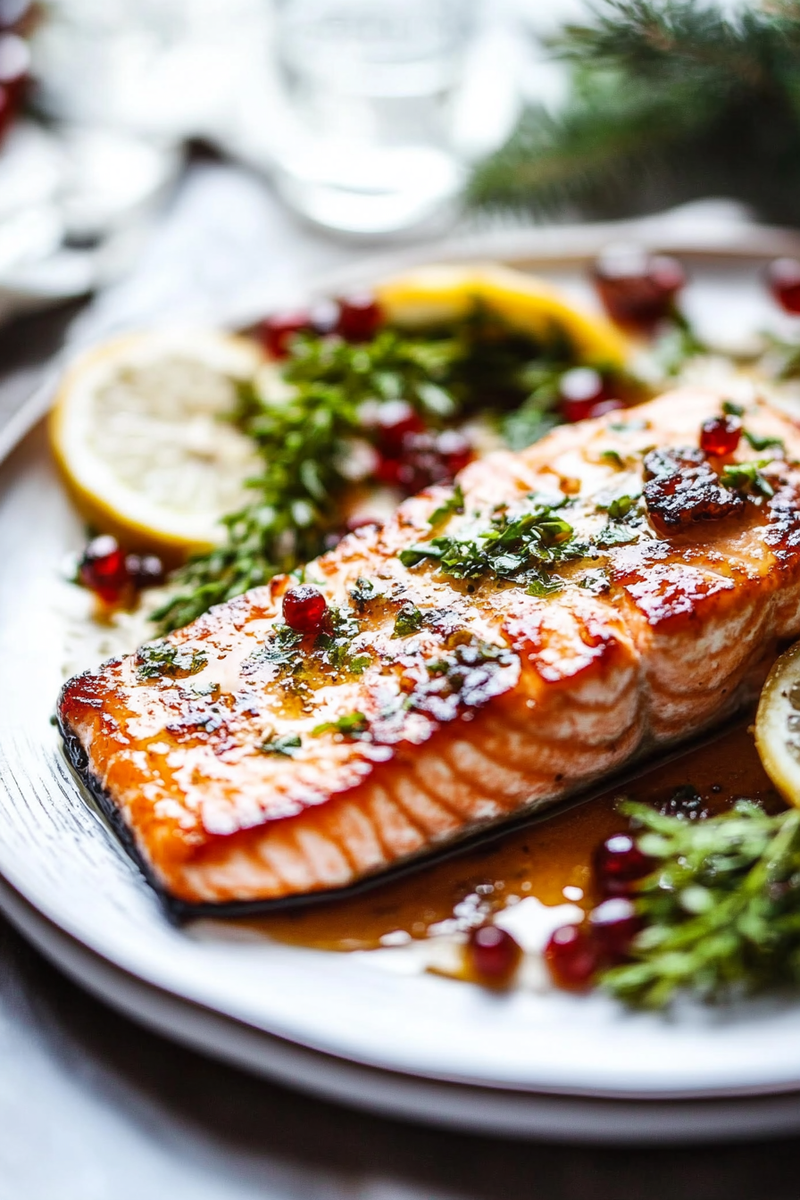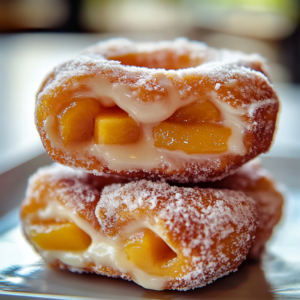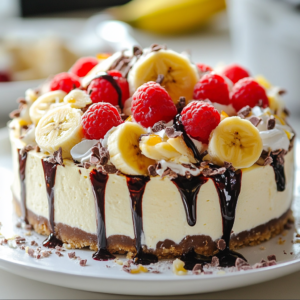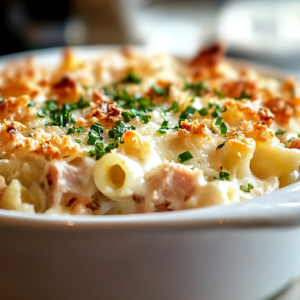Introduction and Quick Summary
Christmas is a time for celebration, joy, and of course, delicious food! Among the many dishes that grace our tables during the holiday season, one standout is undeniably the Christmas salmon. This dish not only offers vibrant flavors but also serves as a delightful centerpiece for any festive gathering. Whether you’re hosting a large family dinner or an intimate gathering with close friends, preparing a succulent piece of salmon elevates your meal to gourmet status.

The beauty of Christmas salmon lies in its versatility. You can prepare it in various ways—baked, grilled, or even smoked—allowing you to cater to different tastes and preferences. Moreover, pairing it with seasonal vegetables and fragrant herbs creates an unforgettable culinary experience that captures the essence of the holidays.
In this article, we’ll dive into a detailed recipe for Christmas salmon that will have your guests raving about your cooking skills. From selecting the right ingredients to step-by-step preparation instructions and serving tips, we’ve got you covered. So roll up your sleeves and get ready to make this year’s holiday meal truly memorable!
Main Ingredients
Fresh Salmon Fillet
Salmon fillet is the star of this dish. Opt for high-quality fresh salmon for the best flavor and texture. The fillet should be about 1-1.5 pounds, which serves approximately four people. Look for bright orange or pink flesh that glistens with moisture; avoid any with brown spots or dullness.
Olive Oil
You’ll need about three tablespoons of extra virgin olive oil to enhance the flavors of the salmon while keeping it moist during cooking. Olive oil adds a rich taste and healthy fats beneficial for heart health.
Lemon Juice
Freshly squeezed lemon juice is essential for balancing the richness of the salmon; use about two tablespoons. The acidity brightens up the dish and complements the fish perfectly.
Garlic
Garlic contributes depth and aroma to your Christmas salmon. You’ll require three cloves minced finely; they add flavor without overpowering the delicate taste of the fish.
Fresh Herbs (Dill & Parsley)
Herbs bring freshness to this dish, so use about two tablespoons each of chopped dill and parsley. These herbs pair wonderfully with fish and add a beautiful pop of color.
Salt & Pepper
Seasoning is crucial! Use one teaspoon of salt and half a teaspoon of black pepper to enhance all other flavors in your dish without overwhelming them.

How to Prepare Christmas Salmon
Preheat Your Oven
Begin by preheating your oven to 375°F (190°C). This temperature allows for even cooking without drying out the fish. While waiting for it to heat up, prepare your baking dish by lining it with parchment paper—this step ensures an easy cleanup after cooking.
Prepare Your Marinade
In a small bowl, whisk together olive oil, lemon juice, minced garlic, salt, and pepper until well combined. This marinade infuses flavors into the salmon as it cooks. Place your salmon fillet skin-side down on a plate or cutting board and pour half of the marinade over it evenly using a brush or spoon.
Add Herbs
Sprinkle chopped dill and parsley over the marinated salmon fillet generously. These fresh herbs not only enhance flavor but also create an aromatic experience that fills your kitchen as it bakes. Allow marinating for at least 15 minutes while you prepare other elements.
Bake Your Salmon
Transfer your marinated salmon onto the prepared baking dish carefully. Bake in your preheated oven for approximately 20-25 minutes or until cooked through—the internal temperature should reach 145°F (63°C). To check doneness accurately, use a fork; if it flakes easily but remains moist inside, it’s perfect!
Garnish & Serve
Once removed from the oven, let your Christmas salmon rest for five minutes before serving—it allows juices to redistribute throughout the fish ensuring each bite is tender and flavorful! Garnish with additional fresh herbs or lemon slices if desired before slicing into portions.

Serving and Storing Tips
Serving Suggestions
When serving your beautiful Christmas salmon dish, consider pairing it with roasted seasonal vegetables such as Brussels sprouts or root vegetables like carrots and parsnips—they add color alongside nutritional value! A light salad dressed with vinaigrette can also complement this meal well by providing refreshing crunchiness against rich flavors.
You may want to offer side options like creamy mashed potatoes or wild rice pilaf; they soak up any juices that may escape from your perfectly baked fish while enhancing presentation on each plate beautifully!
Storing Leftovers
If you find yourself with leftovers after enjoying this festive feast (which is often likely!), store them properly in an airtight container within two hours post-cooking—this helps maintain food safety standards! Refrigerate promptly where leftovers will remain good for up to three days.
When reheating leftovers later on: opt for gentle methods! Using an oven at low temperatures (around 300°F) keeps moisture intact while avoiding dry pieces—about ten minutes should suffice depending on thickness!
By following these steps closely along with our tasty recipe above—you’ll impress family members around this holiday season while creating lasting memories filled with love… And delicious food!
Mistakes to Avoid
One common mistake when preparing Christmas salmon is overcooking. Salmon should be cooked just right to maintain its moist, flaky texture. When you cook it too long, the fish can become dry and unappealing. To avoid this, use a reliable cooking thermometer. The internal temperature should reach 145°F (63°C) for safe consumption while still ensuring the fish remains juicy.
Another frequent error is neglecting to season properly. Christmas salmon deserves a flavorful touch to enhance its natural taste. Many people under-season their fish, leaving it bland. Make sure to use a good mix of herbs, spices, and citrus for a vibrant flavor profile. A simple combination of salt, pepper, lemon zest, and dill can elevate your dish significantly.
Using low-quality ingredients can also ruin your Christmas salmon dish. Freshness matters greatly when it comes to seafood; always choose high-quality salmon from trusted sources. Frozen or previously thawed salmon may lack the same flavor and texture as fresh cuts. If you must use frozen salmon, ensure it is of premium quality and thaw it properly before cooking.
Finally, failing to pair your Christmas salmon with suitable sides can diminish the overall experience. Think about what complements your dish—roasted vegetables or creamy mashed potatoes often work beautifully alongside salmon. Avoid heavy sauces that drown out the fish’s delicate flavors; instead, opt for light dressings or herb-infused oils.
Tips and Tricks
To prepare perfect Christmas salmon, consider marinating your fish beforehand. A simple marinade made of olive oil, garlic, lemon juice, and herbs can infuse incredible flavors into the salmon while also helping to keep it moist during cooking. Aim for at least 30 minutes of marination time for optimal taste.
Cooking methods can greatly affect the final result as well. Baking or grilling are both excellent options for Christmas salmon because they allow for even cooking without drying out the fish. If you choose to grill, make sure your grill is preheated and well-oiled to prevent sticking.
Presentation is key when serving Christmas salmon at festive gatherings. Use garnishes like fresh herbs or citrus slices to enhance visual appeal on the plate. You might also consider serving the salmon on a bed of greens or alongside vibrant vegetable sides that contrast with the rich pink color of the fish.
Don’t forget about timing! Ensure all components of your meal are ready simultaneously so that everything is served hot and fresh. This includes side dishes, salads, and sauces that will accompany your Christmas salmon.
Suggestions for Christmas Salmon
When selecting a recipe for Christmas salmon, consider incorporating seasonal ingredients like cranberries or pomegranates into your dish for a festive touch. These ingredients not only add wonderful flavor but also present beautifully on the plate.
For those looking to impress guests with unique flavors, try experimenting with different types of glazes or crusts on your salmon. A maple-mustard glaze offers a delightful sweetness that pairs exceptionally well with savory elements in the fish.
If you’re hosting a larger gathering during the holidays, consider preparing a whole roasted salmon as an impressive centerpiece. This allows guests to enjoy freshly carved pieces at their leisure while appreciating both presentation and taste.
Lastly, if you have dietary restrictions among guests—such as gluten-free or dairy-free—you can easily adapt most Christmas salmon recipes by using alternative ingredients without sacrificing flavor.

FAQs
What is the best way to season Christmas Salmon?
Seasoning is crucial for enhancing the natural flavors of Christmas salmon. A basic mixture could include salt, black pepper, lemon juice, garlic powder, and fresh herbs like dill or parsley. For an extra kick, consider using chili flakes or mustard powder in small amounts. Apply seasoning generously on both sides before cooking to ensure even flavor distribution throughout each bite.
Can I make Christmas Salmon ahead of time?
Yes! You can prepare certain elements of your Christmas salmon dish ahead of time for convenience during busy holiday festivities. Marinating the fish overnight enhances its flavor significantly without any loss in quality when cooked fresh before serving. Cooked leftovers can be stored in an airtight container in the refrigerator for up to three days but are best enjoyed fresh.
What sides go well with Christmas Salmon?
Pairing sides with your Christmas salmon is essential for creating a balanced meal that everyone enjoys. Recommended sides include roasted seasonal vegetables like Brussels sprouts or carrots tossed with olive oil and herbs—these complement the richness of the fish beautifully. Other great options are creamy mashed potatoes or herbed rice pilaf which offer contrasting textures perfect alongside grilled or baked salmon.
How do I know when my Christmas Salmon is fully cooked?
To determine if your Christmas salmon has reached perfect doneness without cutting into it constantly—using an instant-read thermometer works best! The FDA recommends an internal temperature of 145°F (63°C) when measured at its thickest part; this ensures safety while retaining juiciness in each fillet served!
Can I freeze leftover cooked Christmas Salmon?
Yes! Leftover cooked Christmas salmon can be frozen effectively without compromising quality—just ensure it’s cooled completely first before placing it in airtight freezer-safe containers or bags. It should ideally be consumed within three months after freezing; reheat gently from frozen in an oven set at low heat (around 300°F) until warmed through evenly throughout!
What types of Salmon are best for holiday dishes?
Salmon varieties such as King (Chinook), Sockeye (Red), Coho (Silver), and Atlantic are popular choices due to their rich flavors and beautiful colors on display during festive gatherings! Among these options—King boasts higher fat content giving it buttery richness ideal for special occasions like Christmas parties!
Conclusion
In summary, preparing delicious Christmas salmon requires attention to detail in several areas including cooking techniques and seasoning choices while avoiding common mistakes such as overcooking or under-seasoning! By implementing tips such as marination strategies along with appropriate presentation ideas—you’ll create memorable dining experiences loved by family members alike! Remember always to pair this delectable dish with complementary sides enhancing flavors further elevating any holiday celebration atmosphere making it unforgettable every year!



